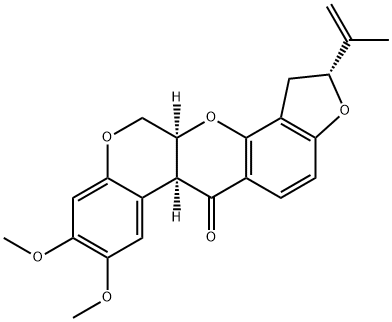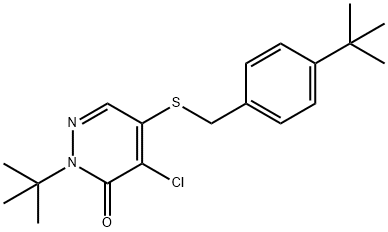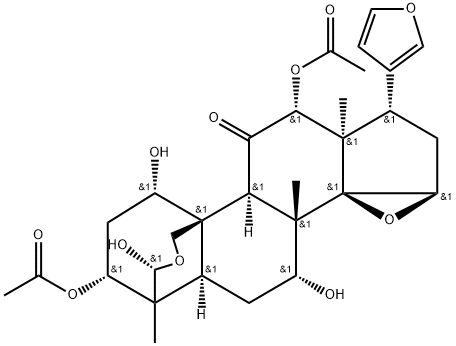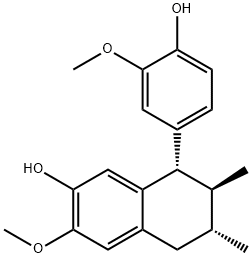Rotenone , 95% , 83-79-4
Synonym(s):
Rotenone - CAS 83-79-4 - Calbiochem
CAS NO.:83-79-4
Empirical Formula: C23H22O6
Molecular Weight: 394.42
MDL number: MFCD09025614
EINECS: 201-501-9
| Pack Size | Price | Stock | Quantity |
| 1G | RMB85.60 | In Stock |
|
| 5G | RMB332.00 | In Stock |
|
| 25G | RMB1225.60 | In Stock |
|
| others | Enquire |
PRODUCT Properties
| Melting point: | 159-164 °C (lit.) |
| Boiling point: | 210-220 °C/0.5 mmHg (lit.) |
| alpha | -115 º (C=1.4 IN CHLOROFORM) |
| Density | 1.1917 (rough estimate) |
| refractive index | 1.4593 (estimate) |
| storage temp. | Keep in dark place,Inert atmosphere,Room temperature |
| solubility | insoluble in EtOH; insoluble in H2O; ≥77.6 mg/mL in DMSO |
| form | White to off-white solid |
| Water Solubility | 15 mg l-1 (100 °C) |
| color | White to Light yellow to Light orange |
| Merck | 14,8271 |
| BRN | 6773081 |
| Stability: | Stable, but light and air sensitive. Combustible. Incompatible with oxidizing agents, especially in the presence of alkalies. |
| InChIKey | JUVIOZPCNVVQFO-HBGVWJBISA-N |
| NIST Chemistry Reference | Rotenone(83-79-4) |
| EPA Substance Registry System | Rotenone (83-79-4) |
Description and Uses
The principal source of rotenone is the tuber root of Derris elliptica; however, it is also extracted from the roots of Derris mallaccensis, Lonchocarpus utilis, and Lonchocarpus uruca. Rotenone is both a stomach and contact poison for arthropods. Its fast knockdown action is attributed to decreasing the availability of nicotinamide adenine dinucleotide to serve as a cofactor in various biochemical pathways including the Krebs cycle, thereby inhibiting the mitochondrial respiratory enzymes.
Rotenone is an broad spectrum insecticide that occurs naturally in seeds and stems of several plants. Rotenone was first registered in 1947 and is currently used exclusively to kill fish (U.S. EPA, 2007). In 2006, registrants voluntarily canceled all livestock, residential and home owner uses, domestic pet uses, and all other uses except for piscicide uses. Currently the main uses include fish management strategies to remove nonnative fish species from lakes, ponds, or streams and in catfish aquaculture prior to stocking ponds with with fry to remove undesirable fish species (U.S. EPA, 2006d).
Rotenone has been historically used by native people to paralyze fish for capture and consumption. Outside the United States, the compound is still used to control insects in fruit and vegetable cultivation and for control of fire ants and mosquito larvae in pond water (HSDB, 2012a).
Safety
| Symbol(GHS) |   GHS06,GHS09 |
| Signal word | Danger |
| Hazard statements | H300+H330-H315-H319-H335-H410 |
| Precautionary statements | P260-P264-P273-P302+P352-P304+P340+P310-P305+P351+P338 |
| Hazard Codes | T,N |
| Risk Statements | 25-36/37/38-50/53 |
| Safety Statements | 22-24/25-36-45-60-61 |
| RIDADR | UN 2811 6.1/PG 3 |
| OEB | B |
| OEL | TWA: 5 mg/m3 |
| WGK Germany | 3 |
| RTECS | DJ2800000 |
| HazardClass | 6.1(b) |
| PackingGroup | III |
| HS Code | 29329990 |
| Hazardous Substances Data | 83-79-4(Hazardous Substances Data) |
| Toxicity | LD50 i.p. in mice: 2.8 mg/kg (Fukami); in rats (mg/kg): 132 orally; 6 i.v. (Soloway) |
| IDLA | 2,500 mg/m3 |




